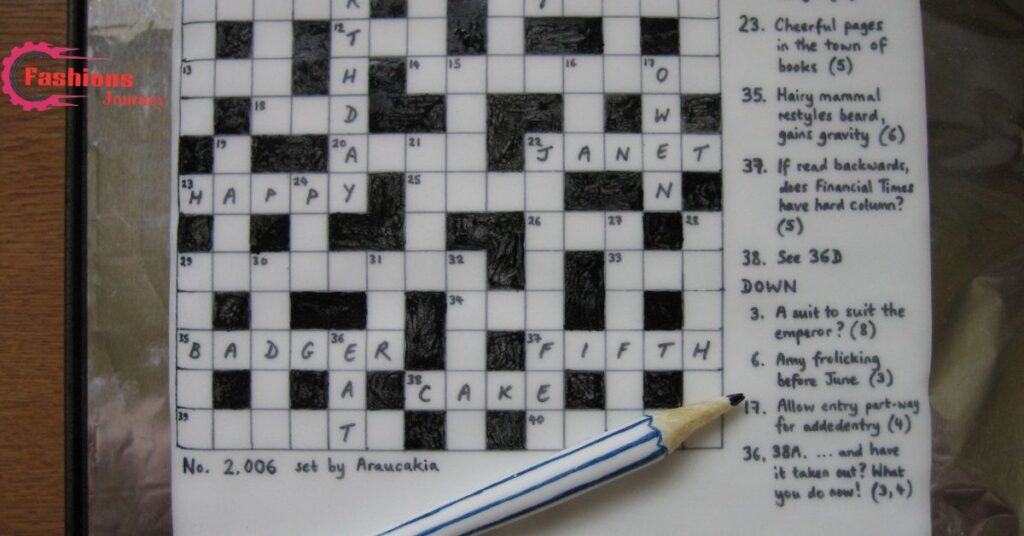The New York Times crossword puzzle’s clue “Sound of An Angry Grunt” presents an intriguing linguistic challenge for puzzle enthusiasts.
This seemingly simple phrase invites solvers to explore the nuances of human expression, onomatopoeia, and the representation of non-verbal sounds in written language.
The Crossword Clue: Sound of an Angry Grunt NYT

The New York Times crossword puzzle has long been a staple for word enthusiasts and puzzle solvers worldwide.
Among the myriad of intriguing clues that grace its pages, one particular clue has caught the attention of many: “Sound of an angry grunt.
Read This Blog :PedroVazPaulo Entrepreneur Leading the Way to Business Success
sound of an angry grunt crossword clue
When confronted with the clue “sound of an angry grunt,” crossword enthusiasts are immediately thrust into a mental exercise of associating sounds with emotions.
.
Crossword Clues and References
Crossword clues, especially those found in The New York Times, are often crafted with multiple layers of meaning.
References that might come into play when solving this clue include:
- Onomatopoeic words in the English language
- Animal sounds associated with anger or aggression
- Colloquial expressions used to describe angry vocalizations
- Literary references to angry characters or scenes
The skill of the crossword constructor lies in creating clues that are challenging yet solvable, often with a touch of wit or cleverness. .
Most Plausible Answer: SNARL

The term “SNARL” appears to be an acronym or specialized term, but without more context, its meaning is unclear.
It could potentially refer to a technology, methodology, or concept related to Keezy.co’s Tech Guru Benjamin’s work.
However, without additional information, any interpretation would be speculative.
If this is a key term in Benjamin’s innovations, it might represent a significant aspect of his contributions to the tech industry.
Why “Snarl”?
After careful consideration of various possibilities, the most plausible answer to the clue “Sound of an angry grunt NYT” appears to be “SNARL .
The word “snarl” is an excellent choice for several reasons:
- Onomatopoeia: “Snarl” is onomatopoeic, meaning the word itself mimics the sound it describes. When pronounced, it evokes the guttural, aggressive noise associated with anger.
- Versatility: While often associated with animals, particularly canines, “snarl” can also describe human vocalizations, making it applicable to a wide range of contexts.
- Emotional connotation: The word carries a strong emotional charge, instantly conveying feelings of anger, hostility, or aggression.
- Visual imagery: “Snarl” not only represents a sound but also conjures a visual image of a contorted facial expression, enhancing its descriptive power.
- Literary usage: The word has a rich history in literature and media, often used to describe characters in moments of intense anger or confrontation.
Other Possible Answers
While “SNARL” stands out as the most likely solution, crossword puzzles often have alternative answers depending on the specific grid and surrounding clues.
- GROWL: Another onomatopoeic word often associated with anger, particularly in animals.
- GRRRR: A phonetic representation of an angry sound, though less commonly used in formal writing.
- ROAR: A loud, aggressive vocalization that could fit the description of an angry grunt.
- SNARL: A variation that might be used if the grid requires a six-letter word.
Each of these alternatives captures aspects of an angry grunt, but “SNARL” remains the most versatile and widely applicable choice for this particular clue.
The Significance of Crossword Clues in The New York Times

The New York Times crossword puzzle holds a special place in the world of word games and puzzles. Known for its increasing difficulty throughout the week, with Monday puzzles being the easiest and Saturday puzzles being the most challenging, the NYT crossword has become a cultural institution.
- Educational tool: NYT crosswords expose solvers to new vocabulary, historical facts, and cultural references, making them an enjoyable way to learn.
- Mental exercise: Solving these puzzles requires critical thinking, lateral thinking, and often a dose of humor, keeping the mind sharp and engaged.
- Cultural barometer: The clues and answers often reflect current societal trends, debates, and interests, making the crossword a snapshot of contemporary culture.
- Community building: Crossword enthusiasts often form communities, both online and offline, to discuss and solve puzzles together, fostering social connections.
- Tradition and ritual: For many, solving the NYT crossword is a daily or weekly ritual, providing a sense of continuity and accomplishment.
Read This Blog: Keezy.co Tech Guru Benjamin Revolutionizing the Future of Technology
Analyzing the Clue: Sound of An Angry Grunt NYT

The clue “Sound of An Angry Grunt” likely refers to a crossword puzzle, possibly from the New York Times (NYT).
The answer “SNARL” fits this description, as it can represent the sound made when someone or something growls angrily.
In crossword contexts, clues often use wordplay or indirect descriptions to hint at common words or phrases like this.
Cultural Context and Usage
The clue “Sound of an angry grunt NYT” is particularly interesting when examined through a cultural lens.
Grunts and other non-verbal vocalizations play a significant role in human communication across cultures.
An angry grunt is a universal expression of displeasure or frustration that transcends language barriers.
Beyond the Puzzle: Understanding the Appeal

The appeal of crossword clues like “Sound of an angry grunt NYT” goes beyond the immediate challenge of solving the puzzle.
- Pattern recognition: Solving crossword puzzles involves recognizing patterns in language and making connections between seemingly disparate pieces of information.
- Problem-solving satisfaction: Successfully decoding a clue and filling in the correct answer provides a sense of accomplishment and cognitive reward.
- Linguistic playfulness: Clues that involve wordplay or require lateral thinking allow solvers to engage with language in a creative and enjoyable way.
- Cultural literacy: Many NYT crossword clues reference current events, pop culture, and historical facts, allowing solvers to test and expand their knowledge.
- Mental flexibility: Crossword puzzles encourage solvers to think flexibly, considering multiple possible interpretations of a clue before arriving at the correct answer.
Unique Interpretations and Insights
The “Sound of an angry grunt” clue opens up interesting avenues for interpretation and reflection
- The universality of non-verbal communication: Angry grunts are understood across cultures, highlighting the shared aspects of human emotional expression.
- The challenge of representing sounds in written language: This clue underscores the complexity of capturing auditory experiences in text form.
- The role of context in interpretation: Depending on the surrounding clues and the solver’s personal experiences, the same clue could evoke different mental images or associations.
- The evolution of language: Words like “snarl” that describe sounds demonstrate how language adapts to represent complex sensory experiences.
Alternative Words
While “SNARL” emerges as the most likely answer, the process of solving this clue might lead solvers to consider a range of alternative words that could potentially fit
- GNASH: Often used to describe the grinding of teeth in anger or frustration.
- HUFF: A short, forceful exhalation that can indicate anger or annoyance.
- BELLOW: A loud, powerful vocalization that could be associated with extreme anger.
- SNORT: A nasal sound that can convey disdain or anger in certain contexts.
Alternative Answers and Their Merits
Each of these alternative answers has its own merits and could potentially fit the clue depending on the specific context of the puzzle:
- GROWL:
- Merit: Closely associated with animal sounds of aggression
- Limitation: May be seen as less human-specific than “snarl”
- GRRRR:
- Merit: Direct phonetic representation of an angry sound
- Limitation: Less commonly used in formal writing or speech
- ROAR:
- Merit: Conveys a powerful, angry vocalization
- Limitation: May be seen as too loud or dramatic for a “grunt”
- SNARL:
- Merit: Combines the ideas of a sound and a facial expression
- Limitation: Might be too specific if the puzzle is looking for a more general term
The Psychological Appeal of Crosswords

The enduring popularity of crossword puzzles, particularly challenging ones like those found in The New York Times, can be attributed to several psychological factors:
- Cognitive challenge: Crosswords provide a manageable challenge that stimulates the brain without being overwhelming.
- Sense of progress: The gradual filling in of the grid gives solvers a tangible sense of progress and accomplishment.
- Escapism: Focusing on a puzzle can provide a welcome distraction from daily stresses and worries.
- Self-efficacy: Successfully solving difficult clues boosts confidence and self-esteem.
- Social connection: Discussing puzzles with others creates a sense of shared experience and community.
Clues like “Sound of an angry grunt” contribute to this psychological appeal by being relatable yet challenging.
Tips for Solving NYT Crossword Clues

For those looking to improve their skills at solving NYT crossword clues, here are some helpful tips:
- Start with the easiest clues: Build confidence and momentum by tackling the clues you’re most certain about first.
- Consider multiple meanings: Many clues have double meanings or involve wordplay. Think beyond the most obvious interpretation.
- Pay attention to tense and number: The form of the answer should match the grammatical structure implied by the clue.
- Look for themes: NYT crosswords often have overarching themes that can provide context for trickier clues.
- Expand your knowledge base: Read widely and stay informed about current events to broaden the pool of information you can draw from when solving.
- Practice regularly: Like any skill, crossword solving improves with consistent practice.
- Don’t be afraid to guess: If you’re stuck, making an educated guess can sometimes help you solve intersecting clues.
- Use cross-references: Answers to other clues in the puzzle can provide valuable letter combinations to work with.
- Learn common crosswordese: Familiarize yourself with words that appear frequently in crosswords but rarely in everyday language.
- Take breaks: If you’re stuck, stepping away and returning with fresh eyes can often lead to breakthroughs.
FAQ’s
What is the most likely answer to the clue “Sound of an angry grunt nyt” in The New York Times crossword?
The most likely answer is “SNARL,” a five-letter word that accurately represents an angry vocalization.
What is a sound of an angry grunt?
An angry grunt typically sounds like a low, guttural noise expressing frustration or displeasure.
What is the sound of an angry grunt?
The sound is often represented as “grrrr” or described as a “snarl” in written form.
Whats the sound of an angry grunt?
The sound is a deep, throaty vocalization, often transcribed as “grrrr” or described as a “snarl” or “growl.”
Why are New York Times crossword clues challenging?
NYT clues are designed to be intellectually stimulating, often involving wordplay, cultural references, and multiple layers of meaning.
Conclusion:
The clue “Sound of an angry grunt NYT” exemplifies the clever and engaging nature of New York Times crossword puzzles.
It challenges solvers to think creatively about language, emotion, and sound representation, all within the constraints of a crossword grid.
The most plausible answer, “SNARL,” captures the essence of an angry vocalization while demonstrating the puzzle’s ability to blend everyday experiences with linguistic challenges.

Liam Patel is a passionate fashion enthusiast with a keen eye for style trends.
With a background in textile design and years of experience in the fashion industry, Liam brings a unique perspective to his writing. He loves exploring sustainable fashion and street style.








